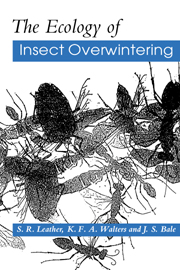6 - Prediction and control
Published online by Cambridge University Press: 16 September 2009
Summary
Introduction
In this chapter we draw together the many aspects of overwintering – survival of different overwintering stages, choice and success of overwintering sites, factors initiating the overwintering response – and discuss their importance to applied biology. In other words, what is the relevance of overwintering to the producer of a plant product, be it timber, cereals, fruit, ornamental plants or whatever? We will first illustrate the importance of a full knowledge of the overwintering habits of insects in forecasting the need for control measures to be taken, i.e. prediction, by reference to specific case studies where this method of prediction is actually employed, then discuss cases where the potential of such systems is under investigation or trial, and finally point out some examples where we feel that this method of prediction could be usefully and profitably utilised.
Ideally, a forecasting system should not involve any winter population sampling. After all, the weather during winter, even in temperate climates, is far from conducive to easy sampling. The ideal system should be based on the assessment of mortality from climatic measurements and from that the likelihood of outbreaks should be determined. One characteristic of all the systems described in this chapter is that although the overwintering stages are sampled, the sampling is done before the onset of winter or, if during the winter, only on stages easily accessible to the sampler. Predictions are then made on the basis of climate and or mortality, and forecasts made from this information.
- Type
- Chapter
- Information
- The Ecology of Insect Overwintering , pp. 177 - 205Publisher: Cambridge University PressPrint publication year: 1993



